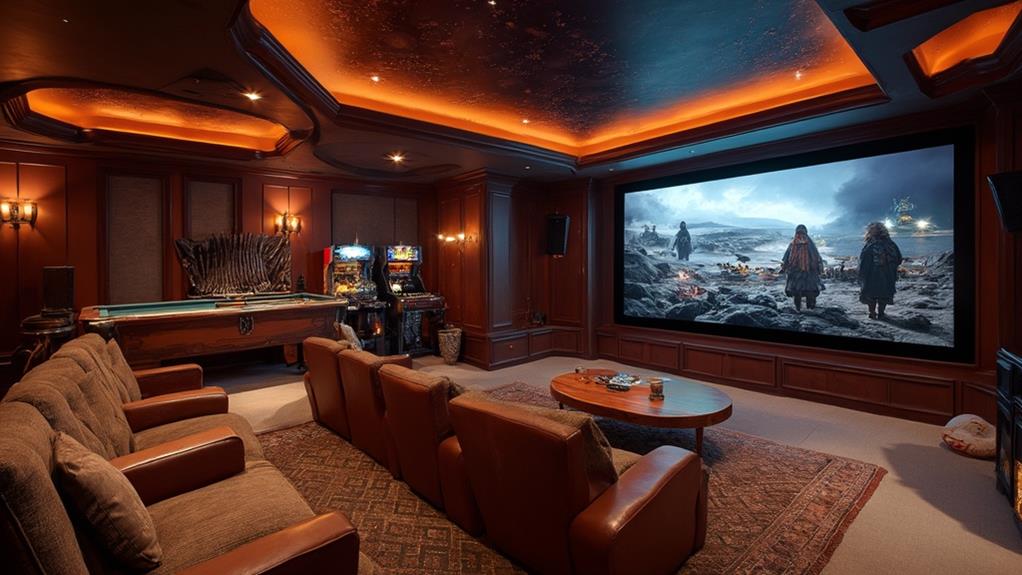Creating a home entertainment space involves careful planning and design. Start by assessing your room's dimensions, acoustics, and infrastructure. Invest in quality audio-visual equipment, including a high-resolution display and surround sound system. Choose comfortable seating options that suit your style and space. Implement proper lighting for ambiance and functionality. For gaming rooms, focus on ergonomic seating and organized storage. Home theaters benefit from tiered seating and acoustic treatments. Optimize storage solutions to keep equipment and media organized. Personalize your space with themed decor and custom touches. By considering these elements, you'll be well on your way to crafting the ultimate entertainment haven.
Assessing Your Space
Before embarking on the creation of a home entertainment space, a critical first step is to thoroughly assess the area you intend to use. Consider the room's dimensions, natural light sources, and existing features such as windows, doors, and electrical outlets. Measure the space accurately, noting any architectural elements that may impact your design choices.
Evaluate the room's acoustics and potential for soundproofing, especially if you plan to install a high-end audio system or create a dedicated home theater. Consider the floor type and whether it can support heavy equipment or specialized seating arrangements. Assess the ceiling height to determine if it can accommodate projector screens or tiered seating.
Examine the room's ventilation and temperature control capabilities, as electronic equipment can generate significant heat. Take note of the existing electrical infrastructure and determine if upgrades are necessary to support your entertainment system. Finally, consider the room's proximity to other living areas and potential noise impact on the rest of the house. This comprehensive assessment will guide your decisions and help you create an optimal home entertainment space.
Audio-Visual Equipment Essentials
With a clear understanding of your space, attention can now turn to the audio-visual equipment that will form the core of your home entertainment system. The centerpiece is typically a high-quality television or projector. For televisions, consider OLED or QLED models for superior picture quality, with 4K resolution as a minimum standard. Projectors offer larger screen sizes but require more controlled lighting conditions.
Audio is equally crucial. A surround sound system, consisting of a receiver and multiple speakers, creates an immersive experience. For smaller spaces, a soundbar with a wireless subwoofer can be an effective alternative. Consider acoustic treatments like sound-absorbing panels to enhance audio quality.
A media player, such as a Blu-ray player or streaming device, is essential for content playback. Smart TVs often have built-in streaming capabilities, but dedicated devices can offer more options and smoother performance. For gaming enthusiasts, include current-generation consoles or a gaming PC.
Don't overlook connectivity. Ensure your space has sufficient HDMI ports, a robust Wi-Fi connection, and possibly ethernet wiring for stable streaming and online gaming. Proper cable management will keep your setup tidy and functional.
Comfortable Seating Options
Central to any home entertainment space, comfortable seating plays a crucial role in enhancing the viewing experience. When selecting seating options, consider both functionality and aesthetics to create an inviting atmosphere. Recliners are a popular choice, offering individual comfort with adjustable positions and built-in features like cup holders and USB ports. For a more traditional cinema feel, opt for theater-style seating with plush upholstery and tiered rows.
Sectional sofas provide versatility, accommodating larger groups and allowing for customizable configurations. Look for models with deep seats and high backs for optimal support during extended viewing sessions. Bean bags and floor cushions offer casual, flexible seating options, particularly appealing for gaming setups or kid-friendly spaces.
For those seeking a luxurious touch, consider installing premium leather chairs or loveseats. These not only provide comfort but also add a sophisticated ambiance to the room. Whatever seating options you choose, ensure they complement the room's dimensions and layout. Proper spacing between seats and the screen is essential for optimal viewing angles and comfort, typically ranging from 1.5 to 2.5 times the screen's diagonal measurement.
Lighting and Atmosphere
Beyond comfortable seating, proper lighting and atmosphere are essential elements in creating an immersive home entertainment space. Lighting plays a crucial role in setting the mood and enhancing the viewing experience. Dimmable LED lights offer flexibility, allowing you to adjust brightness levels for different activities. Consider installing recessed ceiling lights or wall sconces with warm-toned bulbs to create a cozy ambiance.
For a more sophisticated setup, incorporate smart lighting systems that can be controlled via smartphone or voice commands. These systems allow you to program preset lighting scenes for various entertainment scenarios, such as movie nights or gaming sessions. Accent lighting, such as LED strips behind the TV or under furniture, can add depth and visual interest to the room.
To further enhance the atmosphere, consider acoustic treatments like sound-absorbing panels or curtains to improve audio quality and reduce echo. Room-darkening shades or blackout curtains are essential for daytime viewing, ensuring optimal screen visibility. Additionally, incorporating elements like a starry ceiling projector or a gas fireplace can create a unique and immersive environment, elevating your home entertainment space to the next level.
Gaming Room Setup
A dedicated gaming room setup can significantly enhance the overall gaming experience and provide a space for enthusiasts to fully immerse themselves in their favorite titles. When designing a gaming room, consider the following key elements:
First, invest in comfortable seating options that support long gaming sessions, such as ergonomic gaming chairs or plush sofas.
Next, choose a high-quality display system, whether it's a large-screen TV or a gaming monitor with high refresh rates and low input lag. For an immersive audio experience, install a surround sound system or use gaming headsets.
Organize your gaming equipment with purpose-built storage solutions, such as shelving units for game collections and console stands. Proper cable management is crucial for a clean, clutter-free look. Consider adding a PC gaming setup with a powerful gaming rig and peripherals for versatility.
Lighting plays a vital role in creating ambiance; use LED strips or smart lighting systems to enhance the gaming atmosphere. Finally, personalize the space with gaming-themed decor, posters, or collectibles to reflect your passion and create a unique gaming sanctuary.
Home Theater Design
While gaming rooms offer an interactive entertainment experience, home theaters provide a cinematic escape within the comfort of one's own home. Designing a home theater requires careful consideration of several key elements to achieve optimal viewing and audio quality.
The room's layout is crucial, with seating arranged for unobstructed sightlines to the screen. Typically, a tiered seating arrangement enhances the viewing experience. Screen size should be proportionate to the room, with 4K or 8K projectors or large-format TVs as popular options.
Acoustic treatments, such as sound-absorbing panels and bass traps, are essential for superior audio performance. A surround sound system, whether 5.1, 7.1, or Dolby Atmos, immerses viewers in the action. Comfortable seating, like recliners or sectionals, contributes to extended viewing sessions. Lighting control, including dimmable fixtures and blackout curtains, creates the ideal ambiance.
Additional considerations include a dedicated media server for content storage, universal remote controls for seamless operation, and soundproofing to prevent noise disturbance. With careful planning and execution, a home theater can rival the experience of commercial cinemas.
Storage and Organization Solutions
How can a well-organized entertainment space enhance the overall experience? Proper storage and organization solutions not only keep your space tidy but also improve accessibility and functionality. By implementing smart storage systems, you can maximize space utilization and create a clutter-free environment that allows for seamless enjoyment of your entertainment activities.
Consider built-in cabinetry or custom shelving units to house media equipment, gaming consoles, and accessories. Wall-mounted shelves can display collectibles while freeing up floor space. Utilize cable management systems to conceal wires and maintain a clean aesthetic. For media collections, opt for specialized storage solutions like DVD racks or digital libraries to keep content organized and easily accessible.
Incorporate multi-functional furniture pieces, such as ottomans with hidden storage or media consoles with integrated drawers. Use labeled bins or baskets to sort smaller items like remote controls, game controllers, and headphones. Consider vertical storage options to maximize wall space and keep frequently used items within reach. By implementing these storage and organization solutions, you can create a streamlined entertainment space that enhances both form and function.
Personalizing Your Entertainment Area
Beyond implementing practical storage solutions, personalizing your entertainment area is key to creating a space that truly reflects your tastes and interests. Start by selecting a color scheme that complements your existing décor and evokes the desired atmosphere. Consider incorporating themed elements that align with your favorite movies, TV shows, or games. This could include framed posters, collectibles, or custom artwork.
Lighting plays a crucial role in setting the mood. Install dimmable fixtures or smart bulbs to adjust the ambiance for different activities. Add personal touches with throw pillows, blankets, and area rugs that enhance comfort and style. For music enthusiasts, showcase vinyl records or instruments as decorative elements.
Customize your seating arrangement to accommodate your preferences and typical guest count. Consider incorporating a mix of seating options, such as recliners, bean bags, or a sectional sofa. Finally, don't forget to personalize your tech setup with customized screensavers, playlist covers, or gaming skins. These small details can significantly enhance your overall entertainment experience and make the space feel uniquely yours.
Frequently Asked Questions
How Can I Soundproof My Entertainment Space to Avoid Disturbing Others?
To soundproof your entertainment space, consider installing acoustic panels, soundproof curtains, and door seals. Use dense materials like mass-loaded vinyl for walls and ceilings. Add carpeting or area rugs, and ensure proper insulation in walls and windows.
What's the Best Way to Hide Wires and Cables in a Home Theater?
In this digital age, concealing wires in a home theater is paramount. Verily, employ cable management systems, such as raceways or conduits, to neatly route cables behind walls or along baseboards. Alternatively, utilize wireless technologies whenever possible to minimize visible connections.
How Do I Choose the Right Screen Size for My Room Dimensions?
To choose the right screen size, consider your room's dimensions and viewing distance. A general rule is to multiply your seating distance (in inches) by 0.84 for optimal screen width. Balance immersion with comfort for the best experience.
Are Smart Home Integrations Worth Considering for an Entertainment Space?
Smart home integrations are definitely worth considering for an entertainment space. They offer convenient control over lighting, audio, video, and climate systems, enhancing the overall user experience and creating a more seamless, efficient, and enjoyable entertainment environment.
What's the Average Cost to Set up a Basic Home Theater System?
Great Scott! The average cost for a basic home theater system typically ranges from $1,000 to $5,000. This includes an HD projector or large TV, surround sound speakers, an A/V receiver, and necessary cables for setup.
Conclusion
In the realm of home entertainment, the possibilities are truly infinite. From colossal screens that dwarf commercial theaters to gaming setups that rival professional eSports arenas, the home can become an unparalleled nexus of leisure. By meticulously crafting each element—from earth-shattering audio systems to ergonomic seating that cocoons the body—a transcendent entertainment experience emerges. With careful planning and a touch of imagination, even the most modest space can be transformed into an awe-inspiring sanctuary of entertainment that will leave visitors utterly spellbound.

